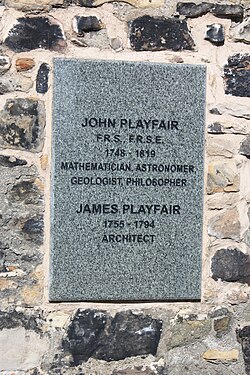| This article includes a list of general references, but it lacks sufficient corresponding inline citations. Please help to improve this article by introducing more precise citations. (September 2022) (Learn how and when to remove this message) |
| James Playfair | |
|---|---|
| Born | (1755-08-05)5 August 1755 Benvie, Forfarshire, Scotland |
| Died | 23 February 1794(1794-02-23) (aged 38) Edinburgh, Scotland |
| Occupation | Architect |
| Spouse | Jessie Graham |
| Children | William Henry Playfair |
| Relatives |
|
| Buildings |
|

James Playfair (5 August 1755 – 23 February 1794) was a Scottish architect who worked largely in the neoclassical tradition.
Biography
Playfair was born in Benvie near Dundee, where his father was the parish minister. He was the brother of William Playfair the engineer, with whom he shared business and living quarters in London; and the mathematician John Playfair, of the University of Edinburgh. He established himself in London in the mid 1780s with the support of politician Henry Dundas, who assisted him in developing a client base largely made up of other Scots. His son, William Henry Playfair (1790–1857), was also a celebrated architect, responsible for many of the buildings in Edinburgh’s New Town.
James Playfair's works include Melville Castle, which he designed for Dundas in Midlothian and the Glens Old Parish Church, Kirriemuir (1786–1788). His most famous building is Cairness House (1791–1797), in Aberdeenshire, which used revolutionary forms of neoclassicism, and is unique in British architecture of the period. Cairness House shows the influence of the French architects Étienne-Louis Boullée and Claude Nicholas Ledoux, and is also notable for having the earliest complete Egyptian room in Britain.
On his death in 1794, most of Playfair's papers were bought by his close friend Sir John Soane and are now housed at Sir John Soane's Museum in London.
References
- "Fitzroy Street," British History Online, https://www.british-history.ac.uk/survey-london/vol21/pt3/pp44-46
- “An Improved School for Building in Scotland": The Architectural Ambitions of James Playfair," A Soane Museum Study Group talk by Rory Lamb